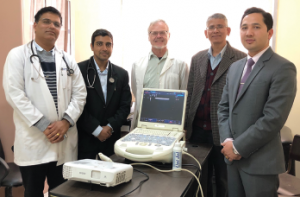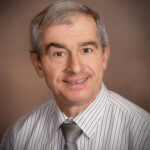
Physicians stand behind the ultrasound Dr. Paul Halverson brought to Patan Hospital, Nepal, for the new rheumatology training program. From left: Drs. Keshav Raj Sigdel, Ujjwal Risal, Paul Halverson, Buddhi Paudyal and Jiwan Poudel.
patrice6000 / shutterstock.com
A Milwaukee rheumatologist delivered lectures, participated in Grand Rounds and consulted on rheumatology treatment strategies during his visit this winter to the Patan Academy of Health Sciences (PAHS), Nepal.
Paul Halverson, MD, affiliated with Froedtert Hospital and the Medical College of Wisconsin, says the several days he spent in Patan, Nepal, adjacent to Kathmandu and the Himalayan foothills, “were great. [The people] were very hospitable and so appreciative of anything that anyone can offer to help them with.”
The mission of PAHS and its teaching hospital, Patan Hospital, is to provide sustained improvement of the health of people in Nepal, particularly people who are poor and living in rural areas. In addition to providing care through its hospitals and clinics, PAHS collaborates with the national health system to improve the health of the people of Nepal and to encourage development of appropriate health policies, programs and systems that will aid the rural poor. PAHS also helps students from underprivileged sectors of the country access health science education.
Patan Hospital, a public hospital and major teaching hospital for PAHS, started an internal medicine residency program in 2017. Its mission is to provide quality and compassionate care to everyone who comes, regardless of their ability to pay. The first public clinic in rheumatology in Nepal was opened October 2018 by Buddhi Paudyal, MD, a professor of medicine at PAHS. Dr. Paudyal was born in Nepal, had an early desire to study medicine, attended medical school and then served a medical residency in Nepal. He was also an Ogryzlo Fellow at the University of Toronto.
A major purpose of Dr. Halverson’s trip was to transport a donated ultrasound machine to Dr. Paudyal’s new rheumatology training program at Patan Hospital. “My fears about bringing the equipment into the country were unfounded; I was waved through customs,” he says.
Dr. Halverson’s journey had begun in Thailand a week before, where he was attending the Christian Dental Medical Association conference. “I happen to go to Thailand every couple of years, and that is not very far from Nepal. I just hopped on over there for about six days.”
Nepal is one of the most impoverished countries in the world, but doctors at the clinic have access to many therapies used in Western rheumatology treatment, except for biologic therapies, Dr. Halverson says. “I was impressed that doctors do have potential access to a lot of modern medical care, although it may require getting meds from India or actually going there.
“No visas are required to go back and forth across the border between India and Nepal. I was led to believe that, on some occasions, someone may go to India to get biologic therapies. However, that is the exception and not the rule, because people just do not have the funds to pay for these drugs, and there is no insurance. So even though obtaining the drugs is a possibility, it is improbable that people will have the money to pay for them.”
Doctors at the clinic “are very aware of Western treatment, and their program and treatment are modeled on Western style medicine,” he says. “Even though physicians talk about how traditional treatments, such as Ayurvedic medicine, continues to draw some patients, people willing to use Western medicine have the usual choices for rheumatologic therapy, such as methotrexate, mycophenolate, sulfasalzine, etc,” he says. “They do have the typical things available, up to about the year 2000 when biologics became available.”
Working with Physicians, Meeting Patients
“While in the clinic, physicians talked to me about their patients and asked whether I would do anything differently. Often, by looking at the responses in their patients, I thought they were doing pretty well, and I agreed with the treatment. It all made sense to me.”
Dr. Halverson delivered a daily lecture in Nepal, “a brain dump to the rheumatology fellows,” he says. The lecture topics covered a broad range: rheumatoid arthritis, gout, lupus, spondyloarthropathies, and joint injections. During Grand Rounds, he gave a talk on the microbiome and how it contributes to spondyloarthritis and other forms of arthritis.
“Medicine is a remarkable way to see a bit more into the culture. You see people with problems who are much more open and willing to interact with a foreigner. You can comfortably look at people and even touch them as part of the medical care, which makes the experience much fuller,” he says.
In talking with the two rheumatology fellows—Ujjwal Risal, MD, and Jiwan Poudel, MD—Dr. Halverson learned more about medicine and the country. “For many years, Nepal hardly had a chance because of political instability, but there is more hope now … but change seems frustratingly slow. The fellows say the culture is changing, especially for the kids who now play videogames, watch YouTube, and engage on the internet to the exclusion of more normal family interaction.”
A car trip with the head of the department on Dr. Halverson’s last full day of his week in Nepal took him east of the Kathmandou Valley, where the Himalayas seemed to “almost mysteriously reach high above the skyline” even though 40 to 50 miles away.
The second leg of the journey that day was a house call on a woman and her daughter, both with rheumatoid arthritis. “This was a family affair at their hilltop farm with three generations, in-laws and some locals coming by. We had lunch and toured the steep hillside farm with several hundred mandarin orange trees and other wonderful produce.
“It was such a privilege to experience Nepali people in a non-urban setting. It was very relaxed and enjoyable. There is real value in Nepal in spending ‘nonproductive’ time together, which seems so different than in the West where everybody has to be doing something, which may or may not mean spending time in relationship with one’s group.”
Clinic Needs
For people who want to volunteer their time by providing teaching assistance at the clinic, Dr. Halverson advises an understanding that the experience will be different. “It’s more rigorous and is not the kind of medicine we have in this country in terms of the facilities and where you are seeing patients. It is a poor country, and they have a lot of beds crowded into the hospital rooms. But that’s the way they have been doing things, and it works for them.”
Dr. Halverson noted that Dr. Paudyal and other physicians at the clinic are “surprisingly relaxed about having other physicians visit, and they are interested in having others come and participate in the educational activities of his program. You can be there with them and maybe examine a patient a little bit, but you are not going there to practice medicine. You would be there more as an educational consultant, teacher.
“The clinic is providing rheumatology services at a higher level than anyone else in the Kathmandou Valley, and they will be recognized for it,” he says.
As for lodging in the country and getting around the crowded, and often unnamed, streets and unmarked buildings, Dr. Halverson advises adopting a flexible approach to scheduling, staying alert on market streets that are teeming with jostling pedestrians and motor bikes, taking time to see the historic and religious sites, and bringing long underwear for those cold nights in a hotel room.
Those interested in volunteering their time should contact Dr. Paudyal via email at [email protected]. For more information about the hospital and PAHS here.
Kathy Holliman, MEd, has been a medical writer and editor since 1997.

